|
Need Help?
|
|
Call
1-800-372-3706
to
speak to a Veterinary Behavior Technician |
|
Paws To Speak!
Member
Main Menu
|

Jumping Up On
People
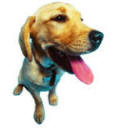
Pet Professional Tip
Consider using head collars in the practice instead
of slip leashes to calm dogs. Use treats to
lure the dog to sit as an alternative to jumping on
you. NEVER pet, praise or greet a dog that
does not have all four feet on the floor.
Squat down to the dog's level if the dog is
friendly. Use your thumb in the collar to
prevent the dog from jumping forward.
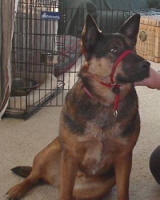
|
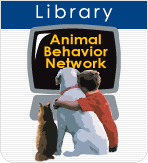 |
|
Help is at your
fingertips by library, email and
phone. |
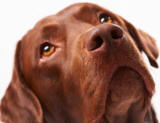
Click on
Library Icon
to learn more
|
How to
Prevent Dogs from Jumping on People
Introduction
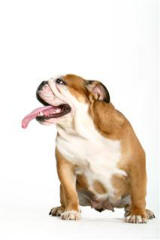 We all love
the unconditional, enthusiastic
greeting that only a dog can
give - no
matter how long, or little, you
have been gone! There is
no other species on earth that
provides this level of
enthusiasm and wiggles of joy.
Dog greetings are something to
look forward to, regardless of
the type of day we have had. We all love
the unconditional, enthusiastic
greeting that only a dog can
give - no
matter how long, or little, you
have been gone! There is
no other species on earth that
provides this level of
enthusiasm and wiggles of joy.
Dog greetings are something to
look forward to, regardless of
the type of day we have had.
These
enthusiastic greetings become
unwanted when the dog jumps on
us and on anyone else that
enters our home or yard. Jumping
on people can be a real nuisance
and is common at around six
months of age on up. This
behavior usually persists
because of inconsistencies among
family members trying to deal
with the issue. Therefore, it is
critical that all family members
agree on how jumping on people
should be handled and how the
dog should be trained not to
jump up.
|
Jumping on people usually
persists because family
members are inconsistent in
the way they respond to the
dog. |
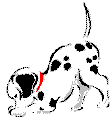 Normal
Canine Behavior Normal
Canine Behavior
It is normal
canine behavior to excitedly greet another
individual of their pack by jumping on that
individual. Other happy natural canine greeting
behaviors might include a "play bow" (lowered front
paws, elevated rump), barking, pawing, spinning, and
any type of physical contact.
Accidental
Reinforcement of Unwanted
Behavior
Many people enjoy physical
contact with their dogs and look
forward to greeting rituals. A
problem occurs when the person
praises and pets the dog as the
dog jumps on them (reinforcing
the behavior). The dog learns to
expect this rowdy social
behavior in all greeting rituals
with all humans.
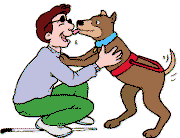 Ironically, most
people who give excited
greetings are unaware that they
are actually training the dog to
jump on them and other people.
When people pet and talk to the
dog in an excited manner when
the dog jumps on them, they give
the dog a message and lesson
that this is acceptable
behavior. People and dogs are
happy to see each other.
However, the dog needs to learn
manners to gain approval in a
human world. If the dog does not
learn manners, often the dog is
the loser because the family
begins to isolate the dog from
people. Ironically, most
people who give excited
greetings are unaware that they
are actually training the dog to
jump on them and other people.
When people pet and talk to the
dog in an excited manner when
the dog jumps on them, they give
the dog a message and lesson
that this is acceptable
behavior. People and dogs are
happy to see each other.
However, the dog needs to learn
manners to gain approval in a
human world. If the dog does not
learn manners, often the dog is
the loser because the family
begins to isolate the dog from
people.
Teaching good
manners and polite greetings
Teach
your dog that it is good manners
to sit when meeting new people
and when greeting you. During
the learning phase, use treats
to show the dog exactly what you
want and to reinforce this
desirable behavior. Ask others
to help you teach the dog how to
greet and meet others by
sitting. Guests and especially
fragile senior citizens will
appreciate a dog that sits
politely for greetings.
The best way to
teach a dog to sit for greetings
is to temporarily ignore the dog
and keep greetings very
low-key, when you first come
home. If the dog jumps up,
instead of giving praise, in a
low, neutral voice say,
"Off."
Then, cross your arms and
turn your side toward the dog.
Try to move in such a way that
the jump fails to make contact.
Some dogs are simply not capable
of controlling themselves at
first. As you go about your
business, intermittently ask for
a "sit." Only greet
the dog after he or she has
calmed down enough to be able to
sit. Then, IMMEDIATELY drop to
your knees and greet the dog on
their level. Put your thumb
under the dog's collar to keep
the dog at arm's distance to
prevent the dog from jumping
forward and to help teach the
dog longer control. If he
or she jumps up from the sit,
just turn away and try again
later. The dog must learn that
the only way to get what he or
she wants (i.e., attention) is
to sit. Do not tell the dog,
"down" to stop jumping as "down"
means to lie down on the ground.
Using one word to mean two
things confuses the dog.
Head HaltersFor owners who have difficulty
gaining verbal control, a head halter and long leash
can be used. Deter the jumping behavior by quickly
stepping on the dog's leash, which will prevent the
dog from jumping. Then immediately ask the dog to
"sit"
and give a reward when he or
she complies. Using this technique, you are
deterring the undesirable behavior (jumping) but
rewarding the preferred behavior (sitting).
Head Collars...Learn
More
|